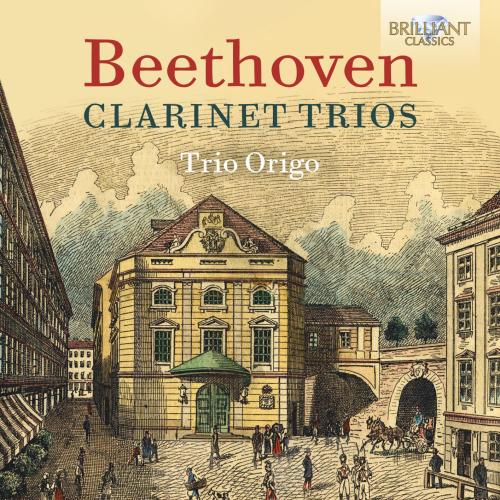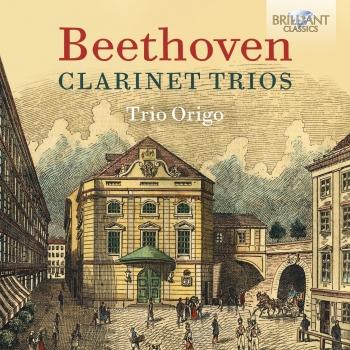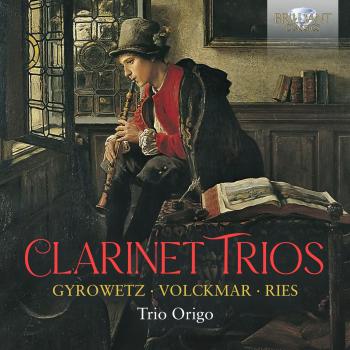
Beethoven: Clarinet Trios Trio Origo
Album Info
Album Veröffentlichung:
2020
HRA-Veröffentlichung:
30.10.2020
Label: Brilliant Classics
Genre: Classical
Subgenre: Chamber Music
Interpret: Trio Origo
Komponist: Ludwig van Beethoven (1770-1827)
Das Album enthält Albumcover Booklet (PDF)
- Ludwig van Beethoven (1770 - 1827): Trio in B-Flat Major, Op. 11:
- 1 Trio in B-Flat Major, Op. 11: I. Allegro con brio 09:10
- 2 Trio in B-Flat Major, Op. 11: II. Adagio 04:40
- 3 Trio in B-Flat Major, Op. 11: III. Tema con variazioni. Pria ch'io l'impegno. Allegretto 07:05
- Trio in E-Flat Major, Op. 38:
- 4 Trio in E-Flat Major, Op. 38: I. Adagio - Allegro con brio 09:59
- 5 Trio in E-Flat Major, Op. 38: II. Adagio cantabile 07:53
- 6 Trio in E-Flat Major, Op. 38: III. Tempo di menuetto 03:43
- 7 Trio in E-Flat Major, Op. 38: IV. Andante con variazioni 07:03
- 8 Trio in E-Flat Major, Op. 38: V. Scherzo. Allegro molto e vivace 03:02
- 9 Trio in E-Flat Major, Op. 38: VI. Andante con moto alla marcia - Presto 07:40
Info zu Beethoven: Clarinet Trios
At the heart of Trio Origo's repertoire are the earliest trios composed for clarinet, cello and piano. The origins of the repertoire lie in the ‘Gassenhauer’ Trio composed by Beethoven in 1797 for a clarinettist, probably Joseph Bähr, who also suggested to the composer that he use a hit tune – known as a ‘Gassenhauer’ – from a recent opera by Joseph Weigl. Beethoven (uncharacteristically, but with perhaps an eye on the work’s future commercial success) duly obliged, and made Weigl’s tune the basis for his theme-and-variations finale – but he also produced a version of the trio substituting the clarinet for the violin to ensure its popularity.
An adroit piece of reverse compositional engineering produced the Op.38 Trio from the Septet Op.20. The Septet was one of Beethoven’s most popular early works, and resulted in a string of arrangements for smaller forces, most of them made by other hands, but the composer himself produced this arrangement for clarinet trio, which happily amplifies the solo instrument’s prominence in the Septet. He never wrote a more joyous melody than the main subject of the first movement, and the work as a whole finds the composer at his most relaxed. While Beethoven’s clarinet writing has never received the attention accorded to Mozart’s, he wrote for it with no less warmth and affection, and this pair of trios displays a winning, sunny side of the composer that is often overshadowed by the cantankerous instrumental dramatist of popular myth and legend.
The Finnish members of Trio Origo all pursue successful careers with chamber and period-instrument ensembles such as the Tapiola Sinfonietta, the Finnish Baroque Orchestra and the Helsinki Baroque Orchestra, but they have been performing Classical-era clarinet trios together since 2004, ranging beyond Beethoven to explore little-known gems by his contemporaries. This recording is the fruit of their study and performing experience over more than 15 years together.
The young Beethoven composed his Trio Op. 11 for piano, cello and clarinet, this relatively new woodwind instrument becoming rapidly popular in his time. The nickname “Gassenhauer” trio is due to the widely popular tune used in the 3rd movement, used in an opera by Joseph Weigl.
The Clarinet Trio Op. 38 is an arrangement by the composer of his own Septet Op. 20, one of his most popular works during his lifetime, and Beethoven milked out its popularity by making several arrangements of it.
Trio Origo (Asko Heiskanen, clarinet, Jussi Seppänen, cello, Jerry Jantunen, fortepiano) is a Finnish trio performing Classical and early Romantic music on period instruments. Its members have all graduated from Sibelius Academy in Helsinki and continued their studies in a.o. Amsterdam, Paris, Berlin, Geneva and Barcelona, gained success in various competitions (Musica Antiqua Brugge, Maj Lind, Crusell) and recorded for several companies (Alpha, BIS, Ondine, Alba, Naxos, Sony, Harmonia Mundi).
Trio Origo
Trio Origo
was formed for a performance of Beethoven’s Trio Op.11 in 2004 when its members were students of the Sibelius Academy. The trio has since then mainly focused on performing Classical and Romantic works on period instruments.
Asko Heiskanen
first studied the clarinet in his hometown of Kuopio, Finland and later on at the Sibelius Academy and the Geneva Conservatory of Music. He also pursued further studies in historical clarinet and chalumeau with Lorenzo Coppola at the Catalonia College of Music in Barcelona. Heiskanen has been successful in competitions, most notably in 1995 when he won first prize in the Crusell Clarinet Competition. He has performed as a soloist with various orchestras and as a chamber musician in many European music festivals. Heiskanen is also a member of the Tapiola Sinfonietta.
Jussi Seppänen
is a versatile cellist who moves with ease between the cello section of the Finnish National Opera, chamber music and various early music groups, ao. the Finnish Baroque Orchestra, the Helsinki Baroque Orchestra and Baccano. He studied cello at the Tampere Conservatory, the Sibelius Academy and the Amsterdam Conservatory.
Jerry Jantunen
started his piano studies at Lappeenranta Music Institute at the age of five. He continued with Hui-Ying Tawaststjerna, Eero Heinonen and Tuija Hakkila at the Sibelius Academy in Helsinki, and graduated in 2007. He also studied the fortepiano with Tuija Hakkila. Jerry Jantunen was a laureate of the Musica Antiqua Brugge fortepiano competition in 2001. He performs as a soloist and chamber musician on both
historical and modern instruments.
Booklet für Beethoven: Clarinet Trios











